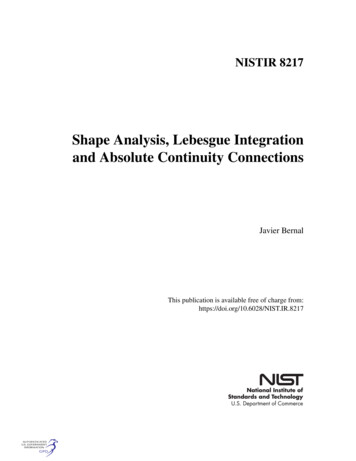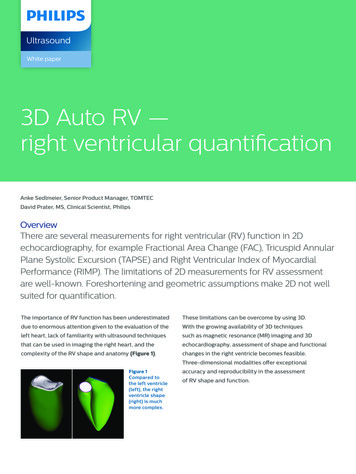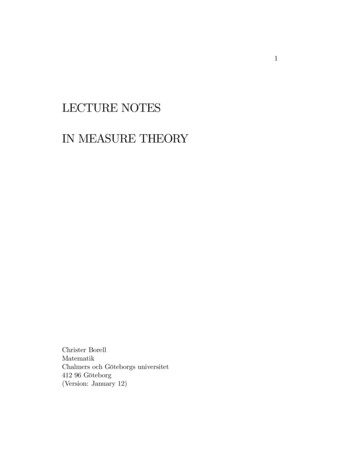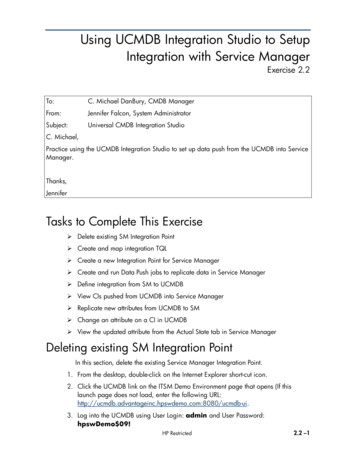
Transcription
NISTIR 8217Shape Analysis, Lebesgue Integrationand Absolute Continuity ConnectionsJavier BernalThis publication is available free of charge from:https://doi.org/10.6028/NIST.IR.8217
NISTIR 8217Shape Analysis, Lebesgue Integrationand Absolute Continuity ConnectionsJavier BernalApplied and Computational Mathematics DivisionInformation Technology LaboratoryThis publication is available free of charge from:https://doi.org/10.6028/NIST.IR.8217July 2018INCLUDES UPDATES AS OF 07-18-2018; SEE APPENDIXU.S. Department of CommerceWilbur L. Ross, Jr., SecretaryNational Institute of Standards and TechnologyWalter Copan, NIST Director and Undersecretary of Commerce for Standards and Technology
This publication is available free of charge from: https://doi.org/10.6028/NIST.IR.8217Shape Analysis, Lebesgue Integration andAbsolute Continuity ConnectionsJavier BernalNational Institute of Standards and Technology,Gaithersburg, MD 20899, USAAbstractAs shape analysis of the form presented in Srivastava and Klassen’stextbook “Functional and Shape Data Analysis” is intricately relatedto Lebesgue integration and absolute continuity, it is advantageousto have a good grasp of the latter two notions. Accordingly, in thesenotes we review basic concepts and results about Lebesgue integrationand absolute continuity. In particular, we review fundamental resultsconnecting them to each other and to the kind of shape analysis,or more generally, functional data analysis presented in the aforemetioned textbook, in the process shedding light on important aspectsof all three notions. Many well-known results, especially most resultsabout Lebesgue integration and some results about absolute continuity, are presented without proofs. However, a good number of results about absolute continuity and most results about functional dataand shape analysis are presented with proofs. Actually, most missingproofs can be found in Royden’s “Real Analysis” and Rudin’s “Principles of Mathematical Analysis” as it is on these classic textbooksand Srivastava and Klassen’s textbook that a good portion of thesenotes are based. However, if the proof of a result does not appear inthe aforementioned textbooks, nor in some other known publication,or if all by itself it could be of value to the reader, an effort has beenmade to present it accordingly.1
This publication is available free of charge from: he concepts of Lebesgue integration and absolute continuity play a majorrole in the theory of shape analysis or more generally in the theory of functional data analysis of the form presented in [23]. In fact, well-known connections between Lebesgue integration and absolute continuity are of greatimportance in the development of functional data and shape analysis of thekind in [23]. Accordingly, understanding functional data and shape analysisas presented in [23] requires understanding the basics of Lebesgue integrationand absolute continuity, and the connections between them. It is the purposeof these notes to provide a way to do exactly that.In Section 2, we review fundamental concepts and results about Lebesgueintegration. Then, in Section 3, we review fundamental concepts and resultsabout absolute continuity, some results connecting it to Lebesgue integration.Finally, in Section 4, we shed light on some important aspects of functionaldata and shape analysis of the type in Srivastava and Klassen’s textbook [23],in the process illustrating its dependence on Lesbesgue integration, absolutecontinuity and the connections between them. Accordingly, without pagenumbers, a table of contents for these notes would be roughly as follows:1. Introduction2. Lebesgue IntegrationAlgebras of sets, Borel sets, Cantor setOuter measureMeasurable sets, Lebesgue measureMeasurable functions, Step functions, Simple functionsThe Riemann integralThe Lebesgue integralThe Lp Spaces3. Absolute Continuity and its Connections to Lebesgue Integration4. Functional Data and Shape Analysis and its Connections to LebesgueIntegration and Absolute ContinuitySummaryAcknowledgementsReferencesIndex of TermsThe material in these notes about Lebesgue integration and absolute continuity is mostly based on Royden’s “Real Analysis” [16] and Rudin’s “Principles of Mathematical Analysis” [18]. The fundamental ideas on functional2
This publication is available free of charge from: https://doi.org/10.6028/NIST.IR.8217data and shape analysis are mostly from Srivastava and Klassen’s “Functional and Shape Data Analysis” [23]. An index of terms has been includedat the end of the notes.2Lebesgue IntegrationAlgebras of sets, Borel sets, Cantor setDefinition 2.1: A collection A of subsets of a set X is called an algebraon X if for A, B in A, A B is in A, and for A in A, Ã X \ A is in A.Observation 2.1: From De Morgan’s laws if A is an algebra, then for A, Bin A, A B is in A.Definition 2.2: An algebra A is called a σ-algebra if the union of everycountable collection of sets in A is in A.Observation 2.2: From De Morgan’s laws if A is a σ-algebra, then theintersection of a countable collection of sets in A is in A.Definition 2.3: A set of real numbers O is said to be open if for each x Othere is δ 0 such that each number y with x y δ belongs to O. A setof real numbers F is said to be closed if its complement in R is open, i.e.,R \ F is open, where R is the set of real numbers. The collection of Borelsets is the smallest σ-algebra on the set R of real numbers which containsall open sets of real numbers.Observation 2.3: The collection of Borel sets contains in particular allclosed sets, all open intervals, all countable unions of closed sets, all countableintersections of open sets, etc.Proposition 2.1: Every open set of real numbers is the union of a countablecollection of disjoint open intervals. Proof in [16].Proposition 2.2 (Lindelöf): Given a collection C of open sets of real3
This publication is available free of charge from: https://doi.org/10.6028/NIST.IR.8217numbers, then there is a countable subcollection {Oi } of C with O C O i 1 Oi .Proof in [16].Definition 2.4: A set of real numbers F is said to be compact if everyopen cover of F contains a finite subcover, i.e., if C is a collection of opensets of real numbers such that F O C O, then there is a finite subcollection{Oi , i 1, . . . , n} of C with F ni 1 Oi .Proposition 2.3 (Heine-Borel): A set of real numbers F is compact ifand only if it is closed and bounded. Proof in [16] and [18].Proposition 2.4: Given a collection K of closed sets of real numbers suchthat at least one of the sets is bounded and the intersection of every finitesubcollection of K is nonempty, then F K F 6 . Proof in [16] and [18].Definition 2.5: A number x is said to be a limit point of a set of realnumbers E if every open set that contains x contains y 6 x, y in E.Definition 2.6: A set of real numbers E is said to be perfect if it is closedand if every number in E is a limit point of E.Proposition 2.5: A set is closed if and only if every limit point of the setis a point of the set. A nonempty perfect set is uncountable. Proofs in [18].Corollary 2.1: Every interval is uncountable, thus the set of real numbersis uncountable.Observation 2.4: Let E1 be the union of the intervals [0, 31 ], [ 32 , 1] that areobtained by removing the open middle third of the interval [0, 1]. Let E2be the union of the intervals [0, 19 ], [ 29 , 39 ], [ 69 , 79 ], [ 89 , 1] that are obtained byremoving the open middle thirds of the intervals [0, 13 ] and [ 32 , 1]. Continuingthis way, a sequence of compact sets En is obtained with En En 1 forevery positive integer n. The set n 1 En , called the Cantor set, is compact,nonempty, perfect thus uncountable, and contains no interval. Proofs in [18].4
This publication is available free of charge from: https://doi.org/10.6028/NIST.IR.8217Definition 2.7: The extended real numbers consist of the real numberstogether with the two symbols and . The definition of is extendedby declaring that if x is a real number, then x . The operation is left undefined, the operation 0 · ( ) is defined to be 0, whileother definitions are extended: If x is a real number, thenx ,x ,x/ x/ 0,x · ,x · if x 0,x · ,x · if x 0.Finally , , · ( ) , · ( ) .Outer measureDefinition 2.8: Given a set A of real numbers, the outer measure m Aof A is the extended real number defined bym A infA InXl(In ),where the {In } are countable collections of open intervals that cover A, andl(In ) is the length of the interval In .Observation 2.5: m is a set function, m 0, m A m B if A B,and the outer measure of a set consisting of a single point is zero.Proposition 2.6: m (I) l(I) if I is an interval. Proof in [16].Proposition 2.7: Countable subadditivity of m : m ( An ) m Anfor any countable collection {An } of sets of real numbers. Proof in [16].PCorollary 2.2: m A 0 if A is countable.Observation 2.6: The Cantor set is an example of an uncountable set withouter measure zero. Proof in [18].Proposition 2.8: m is translation invariant, i.e., m (E y) m E for any5
This publication is available free of charge from: https://doi.org/10.6028/NIST.IR.8217set E of real numbers and any number y, where E y {x y : x E}.Proof: If {In } is a countable collection of open intervals that covers E, then{In y} is a countable collection of open intervals that covers E y. Sincel(In ) l(In y) for each n, then m (E y) m E. Similarly, if {In } is acountable collection of open intervals that covers E y, then {In y} covers E,l(In ) l(In y), and therefore m E m (E y). Thus, m E m (E y).Proposition 2.9: For any set A of real numbers and any ǫ 0, there is anopen set O with A O and m O m A ǫ (m O m A ǫ if m A ).In addition, there is a set G that is the intersection of a countable collectionof open sets with A G and m G m A.Proof: From the definition of the outer measure there is a countable collecPtion {In } of open intervals that covers A with l(In ) m A ǫ. WithPO In , then O is open, A O, and m O l(In ) m A ǫ,which proves the first part. Now let k 0 be an integer. Then fromthe first part there is an open set Ok , A Ok , with m Ok m A k1 .With G k 1 Ok , then for any integer n 0 we have A G Onand therefore m A m G m On m A n1 . Letting n , thenm A m G m A. Thus m A m G, which proves the second part.Measurable sets, Lebesgue measureDefinition 2.9 (Carathéodory’s criterion): A set E of real numbers issaid to be (Lebesgue) measurable if for every set A of real numbers, thenm A m (A E) m (A Ẽ),Ẽ the complement of E in R, i.e., Ẽ R \ E, R the set of real numbers.Observation 2.7: Clearly Ẽ is measurable if and only if E is, and and theset R of real numbers are measurable. As for an example of a nonmeasurableset, a rather complex one is presented in [16]. Finally, note that it is alwaystrue that m A m (A E) m (A Ẽ), thus E is measurable if and onlyif for every set A we have m A m (A E) m (A Ẽ).6
This publication is available free of charge from: https://doi.org/10.6028/NIST.IR.8217Proposition 2.10: If m E 0, then E is measurable.Proof: For any set A, since A A Ẽ, m E 0, and E A E, thenm A m (A Ẽ) m (A Ẽ) m (E) m (A Ẽ) m (A E).Proposition 2.11: The collection of measurable sets is a σ-algebra on R.Proof in [16].Definition 2.10: The Lebesgue measure m is the set function obtainedby restricting the set function m to the collection of (Lebesgue) measurable sets.Proposition 2.12: Countable subadditivity of m: m( An ) mAnfor any countable collection {An } of measurable sets (Proposition 2.7).PCountable additivity of m: m( An ) mAn if the sets in {An } as aboveare pairwise disjoint. Proof in [16].PObservation 2.8: It is in the proof of countable additivity of the Lebesguemeasure m that Carathéodory’s criterion plays a major role. On the otherhand, the importance of the countable additivity of m is immediately apparent in the proofs of the two parts of the following very useful proposition.Proposition 2.13 (Nested sequences of measurable sets Lemma):1. Given a countable collection of measurable sets {En } with En 1 En foreach n, mE1 , then m( i 1 Ei ) limn mEn .2. Given a countable collection of (not necessarily measurable) sets {En } with En 1 En for each n, then m ( i 1 Ei ) limn m En .Proof in [16] for the first part. In [14] for the second part using Proposition 2.9. As mentioned above, in the proofs of both parts the countableadditivity of m (Proposition 2.12) is used.Proposition 2.14: Every Borel set is measurable. Proof in [16].Observation 2.9: A rather complex example of a measurable set that isnot Borel is presented in [4].7
This publication is available free of charge from: https://doi.org/10.6028/NIST.IR.8217Proposition 2.15 (Equivalent conditions for a measurable set): LetE be a set of real numbers. Then the following five conditions are equivalent:i. E is measurable.ii. Given ǫ 0, there is an open set O, O E with m (O \ E) ǫ.iii. Given ǫ 0, there is a closed set F , F E with m (E \ F ) ǫ.iv. There is a set G that is the intersection of a countable collection of opensets, G E with m (G \ E) 0.v. There is a set F that is the union of a countable collection of closed sets,F E with m (E \ F ) 0.Proof: We only prove i ii. Proofs of all cases in [17].i ii: E is measurable.Case 1: mE .There exists O open such that E O, mO mE ǫ (Proposition 2.9).mE then implies mO mE ǫ. Accordingly,ǫ m(O E) m(O Ẽ) mE mE m(O \ E) mE m(O \ E).Case 2: mE .For each integer n 0 let En E ((n 1, n] ( n, n 1]). Then eachEn is measurable, mEn , and E En . From Case 1 above it followsthat there is On open such that En On and m(On \ En ) ǫ/2n . WithO On , then O is open, E O and O \ E (On \ En ). Thus,m(O \ E) m( (On \ En )) Xm(On \ En ) Xǫ/2n ǫ.ii i: Given ǫ 0, there is an open set O, O E with m (O \ E) ǫ.O open implies O is measurable. Thus, for any set A, we have m A m (A O) m (A Õ). Accordingly,m A ǫ m A m (O Ẽ)m (A O) m (A Õ) m (O Ẽ)m (A E) m (A Õ Ẽ) m (O Ẽ A)m (A E) m (A Ẽ).ǫ arbitrary implies m A m (A E) m (A Ẽ). Thus, E is measurable.8
This publication is available free of charge from: https://doi.org/10.6028/NIST.IR.8217Corollary 2.3: Every (Lebesgue) measurable set is the union of a Borel setand a set of (Lebesgue) measure zero.Proposition 2.16: The translate of a measurable set is measurable, i.e., ifE is a measurable set, then E y is measurable for any number y.Proof: For any set A, setting B A y, F E y, and noting (B E) y A F , (B Ẽ) y A F̃ , by Proposition 2.8, thenm A m B m (B E) m (B Ẽ) m (A F ) m (A F̃ ).Thus, F E y is measurable.Measurable functions, Step functions, Simple functionsDefinition 2.11: Let f be an extended real-valued function defined on a(Lebesgue) measurable set. Then f is said to be (Lebesgue) measurableif the set {x f (x) a} is (Lebesgue) measurable for every real number a.Proposition 2.17 (Equivalent conditions for a measurable function):Let f be an extended real-valued function of measurable domain. Then thefollowing conditions are equivalent:i. {x f (x) a} is measurable for every real number a.ii. {x f (x) a} is measurable for every real number a.iii. {x f (x) a} is measurable for every real number a.iv. {x f (x) a} is measurable for every real number a.Proof in [16] and [18].Observation 2.10: Conditions ii, iii, iv can be used instead of condition i todefine a measurable function. We note that if a real-vaued function f definedon a closed or open interval I is continuous [18], then f is measurable sincethe set in condition i is relatively open in I [18]. Also the restriction of ameasurable function to a measurable subset of its domain, is measurable.Definition 2.12: Given real numbers a, b, a b, and an integer n 0,by a partition or subdivision of [a, b] we mean a finite set of pointsP {ξ0 , ξ1 , . . . , ξn } with a ξ0 ξ1 . . . ξn b. A function ψ : [a, b] 9
This publication is available free of charge from: https://doi.org/10.6028/NIST.IR.8217R is called a step function (on [a, b]) if for an integer n 0, there arenumbers ci , i 1, . . . , n, and a partition or subdivision P {ξ0 , ξ1 , . . . , ξn }of [a, b], such that ψ(a) ψ(ξ0 ) c1 , ψ(x) ci , ξi 1 x ξi , i 1, . . . , n.Definition 2.13: Given sets A, X of real numbers, A X, the characteristic function χA of A on X, χA : X {0, 1}, is defined byχA (x) (1 x A0 x X \ A.Definition 2.14: Given a measurable set E, an integer n 0, and fori 1, . . . , n, nonzero numbers ci , measurable sets Ei E, and characteristic functions χEi of Ei on E, a function ϕ : E R defined by ϕ(x) Pni 1 ci χEi (x) for x in E is called a simple function on E.Observation 2.11: Step functions are measurable and a function is simpleif and only if it is measurable and assumes only a finite number of values.We note that the representation of a simple function ϕ is not unique. However it does have a so-called canonical representation: for some integerPm 0, ϕ(x) mi 1 ai χAi (x) for x in E, where {a1 , . . . , am } is the set ofdistinct nonzero values of ϕ, and Ai {x E : ϕ(x) ai }, i 1, . . . , m.This representation is characterized by the fact that the ai ’s are distinct andnonzero, and the Ai ’s are pairwise disjoint.Proposition 2.18: If f is a measurable function, then the function f ismeasurable. Proof in [18].Proposition 2.19: Let f and g be measurable real-valued (not extended)functions defined on the same domain X, c a constant, and F a continuous real-valued function on R2 . Then the function h defined by h(x) F (f (x), g(x)), x X, is measurable. In particular f g, f g, cf , f c, f gare measurable; f /g is measurable if g 6 0 on X. Proofs in [16] and [18].Observation 2.12: For extended real-valued measurable functions f and g,the function f g is still measurable. However in order for f g to be measurable, f g must be given the same value at points where it is undefined,unless these points form a set of measure zero in which case it makes no10
This publication is available free of charge from: https://doi.org/10.6028/NIST.IR.8217difference which values f g is given on the set.Proposition 2.20: Let {fn } be a sequence of measurable functions definedon the same domain X and let N 0 be an integer. The functions definedfor each x X by supn N fn (x), supn fn (x), lim supn fn (x), inf n N fn (x),inf n fn (x), lim inf n fn (x), are all measurable. Proofs in [16] and [18].Definition 2.15: Given a set of real numbers X, a property associated withpoints in X is said to hold almost everywhere (a.e. for short) in X if theset of points in X where the property fails has measure zero.Proposition 2.21: Let f and g be functions defined on the same measurable domain X. If f is measurable and f g a.e., then g is measurable.Proof: Let a be any real number. f g a.e. means the set E {x : f (x) 6 g(x)} has measure zero. Thus E and the set {x E : g(x) a} E aremeasurable (Proposition 2.10). X \ E must then be measurable and the set{x X \ E : f (x) a} is then measurable as f is measurable. Thus, since{x : g(x) a} {x X \ E : f (x) a} {x E : g(x) a}it follows that {x : g(x) a} is measurable and therefore g is measurable.Observation 2.13: The definition of a measurable function and 1 of Proposition 2.13 allow the following proposition to be true.Proposition 2.22 (Egoroff’s Theorem): Let {fn } be a sequence of measurable functions on a measurable set E, mE , that converge a.e. to areal-valued (not extended) function f on E, i.e., there is a set B E suchthat mB 0, fn f pointwise on E \ B. Then for every δ 0 there is aclosed set F E such that m(E \ F ) δ and fn f uniformly on F .Proof: Let m 0 be an integer. For each integer n 0 letGmn {x E : fn (x) f (x) 1/m},and for each integer N 0 setmmEN n N Gn {x E : fn (x) f (x) 1/m for some n N}.11
This publication is available free of charge from: https://doi.org/10.6028/NIST.IR.8217We note f is measurable (Proposition 2.20 and Proposition 2.21). It followsmmmthat each ENis measurable and of finite measure, EN 1 EN , and for eachmx E \ B there must be some N for which x 6 EN, since fn (x) f (x).mThus EN B and must therefore have measure zero. It follows then thatmlimN mEN 0 (1 of Proposition 2.13). Hence there exists N such thatmmEN m({x E : fn (x) f (x) 1/m for some n N}) δ/2m 1 .mLetting Am EN, then Am is measurable, mAm δ/2m 1 andE \ Am {x E : fn (x) f (x) 1/m for all n N}. mmm 1Now let A δ/2.m 1 A . Then mA m 1 mA m 1 δ/2Given ǫ 0 choose integer m 0 with 1/m ǫ. For some N and for allx E \ A then x E \ Am and fn (x) f (x) 1/m ǫ for all n N.Thus, fn f uniformly on E \ A.Finally, let G E \ A. Clearly G is measurable and m(E \ G) mA δ/2.Thus, there exists a closed set F , F G with m(G \ F ) δ/2 (Proposition 2.15). It then follows that m(E\F ) m(E\G) m(G\F ) δ/2 δ/2 δ and fn f uniformly on F .PPProof also in [8] for spaces and measures more general than R and theLebesgue measure.Observation 2.14: The assumption mE is necessary in the aboveproposition. To see this, let E R andfn (x) (1 x n0 x n.Clearly fn 0 pointwise on E. However, for any integer N 0, 0 ǫ 1,the set {x E : fN (x) ǫ} (N, ) is of infinite measure. Thus, theuniform convergence of fn to 0 as proposed in the proposition can not occur.Definition 2.16: Given a function f defined on a set E, the positive partf of f and the negative part f of f are the functions defined respectivelyby f (x) max{f (x), 0}, and f (x) max{ f (x), 0}, x E.12
This publication is available free of charge from: https://doi.org/10.6028/NIST.IR.8217Proposition 2.23 (Approximation of a measurable function by simple functions): Let f be a real-valued (not extended) measurable functionon a measurable set E. Then there exists a sequence of simple functions {sn }on E such that sn f pointwise on E. Since f f f , and f and f are measurable because f is, then {sn } can be chosen so that sn sun sln ,where sun and sln are simple functions on E such that sun f , sln f pointwise on E, and sun and sln increase monotonically to f and f , respectively. If f is bounded, then {sn } can also be chosen to converge uniformlyto f on E. Proof in [18].Proposition 2.24 (Lusin’s Theorem): Let f be a real-valued (not extended) measurable function on a measurable set E. Then given ǫ 0, thereexists a closed set F E with m(E \ F ) ǫ such that f F is continuous.Proof: First we prove the proposition for f a simple function on E. AccordPingly, for some integer n 0, assume f (x) ni 1 ci χEi (x) for x in E, Ei Efor each i, the canonical representation of f . In addition let E0 E \ ni 1 Ei .Clearly the Ei ’s are pairwise disjoint. Given ǫ 0, since each Ei is measurable there exists a closed set Fi Ei such that m(Ei \ Fi ) ǫ/(n 1),i 0, . . . , n (Proposition 2.15). Accordingly, F ni 0 Fi is closed, andm(E \ F ) m( ni 0Ei \ ni 0Fi ) m( ni 0 (Ei\ Fi )) nXi 0m(Ei \ Fi ) ǫ.Now, to show f F is continuous we show that if {xk }, x in F are such thatxk x, then f (xk ) f (x).We note that for some unique j, 0 j n, it must be that x Fj . Thus,since f is constant on Fj , it then suffices to show that for some integer K 0,xk is in Fj for k K. If this is not the case and since there is a finite numberof Fi ’s then for some l, 0 l n, l 6 j, there is a subsequence {xkm } of {xk }all contained in Fl . But then xkm x so that x is in Fl , a contradiction.Now we prove the proposition for a general f .Case 1: mE .Let sn be simple functions such that sn f pointwise on E (Proposition 2.23). Given ǫ 0, as established above for simple functions on E,for each n there exists a closed set Fn E with m(E \ Fn ) ǫ/2n 1 suchthat sn Fn is continuous. In addition, since mE , there exists a closed13
This publication is available free of charge from: https://doi.org/10.6028/NIST.IR.8217set F0 E such that m(E \ F0 ) ǫ/2 and sn f uniformly on F0 (Proposition 2.22 (Egoroff’s Theorem)).Finally let F n 0 Fn . Then F is closed andm(E \ F ) m( n 0 (E \ Fn )) Xn 0m(E \ Fn ) Xǫ/2n 1 ǫ.n 0Since sn Fn is continuous so must be sn F . And since sn f uniformly onF F0 then f F must be continuous (proof in [18]).Case 2: mE .For each integer n 0, let Ẽn (n 1, n] ( n, n 1] and En E Ẽn .Then each En is measurable, mEn , and E n 1 En . From Case 1above, given ǫ 0, it follows that there is a closed set Fn En with m(En \Fn ) ǫ/2n such that f Fn is continuous. Let F n 1 Fn . Then m(E \ F ) m( n 1 En \ n 1 Fn ) m( n 1 (En \ Fn )) Xn 1m(En \ Fn ) Xǫ/2n ǫ.n 1We show F is closed. Let x be a limit point of F so that for {xk } in F , thenxk x. Clearly for some integer j 0 it must be that x Ẽj . It suffices toshow that for some integer K 0, xk is in Fj for k K so that x is also inFj F . With Ẽn for n 0, from the definition of the Ẽn ’s a neighborhood of the point x exists that does not intersect Ẽi , i j 1 or i j 1.Thus, with F0 , for k large enough the points xk can only be in Fj i , Fjand Fj 1 . If it is not the case that K as described exists, then there must bea subsequence {xkm } of {xk }, all of it contained in either Fj 1 or Fj 1 . Butthen xkm x so that x is in either Fj 1 or Fj 1 , a contradiction. (Actuallyshowing that x is in the union of Fj 1 , Fj and Fj 1 , would have sufficed).Now, to show f F is continuous we show that if {xk }, x in F are such thatxk x, then f (xk ) f (x).We note that for some unique j 0, it must be that x Fj . Thus, since fis continuous on Fj , it then suffices to show that for some integer K 0, xkis in Fj for k K. If this is not the case, again with F0 , an argument,similar to the one used above for proving F is closed, can be used to get thesame contradiction that x is in either Fj 1 or Fj 1 .14
This publication is available free of charge from: https://doi.org/10.6028/NIST.IR.8217The Riemann integralDefinition 2.17: Let [a, b] be an interval and f a bounded real-valued function defined on [a, b]. Given an integer n 0, and P {ξ0 , ξ1 , . . . , ξn }, apartition or subdivision of [a, b] (Definition 2.12), for i 1, . . . , n, we definemi inf f (x), ξi 1 x ξi ,Mi sup f (x), ξi 1 x ξi , andnXL(P, f ) i 1nXU(P, f ) i 1mi (ξi ξi 1 ),Mi (ξi ξi 1 ).Then we define the lower Riemann integral and the upper Riemannintegral of f over [a, b], respectively, byZbZbRaRf (x)dx sup L(P, f ),Paf (x)dx inf U(P, f ),Pwhere the infimum and supremum are taken over all partitions P of [a, b].If the two are equal, f is said to be Riemann integrable over [a, b], andthe common value is then called the Riemann integral of f over [a, b] anddenoted byZRbaf (x)dx.Observation 2.15: Since f is bounded, there exist numbers m and M, suchthat m f (x) M, x [a, b]. Thus, for every partition P , it must be thatm(b a) L(P, f ) U(P, f ) M(b a), so that the lower and upperRiemann integrals of f over [a, b] are finite numbers.Proposition 2.25: R ab f (x)dx R ab f (x)dx. Proof in [18].RRObservation 2.16: Let ψ : [a, b] R be a step function so that for aninteger n 0, there are numbers ci , i 1, . . . , n, and a partition P {ξ0 , ξ1, . . . , ξn } of [a, b], such that ψ(a) ψ(ξ0 ) c1 , ψ(x) ci , ξi 1 x ξi ,15
This publication is available free of charge from: https://doi.org/10.6028/NIST.IR.8217i 1, . . . , n. Clearly L(P, ψ) U(P, ψ) and since L(P, ψ) R ab ψ(x)dx RR ab ψ(x)dx U(P, ψ) (Proposition2.25), it must be that ψ is RiemannRPintegrable over [a, b] and R ab ψ(x)dx ni 1 ci (ξi ξi 1 ).From this it is then apparent thatRZbZbRaRbZbf (x)dx sup L(P, f ) sup RPaZaψ ff (x)dx inf U(P, f ) inf RPψ faψ(x)dx,ψ(x)dx,where the ψ’s are all possible step functions on [a, b] satisfying the givenconditions.Definition 2.18: Given an interval [a, b], let P {ξ0 , ξ1, . . . , ξn } be a partition of [a, b]. The numberµ(P ) max (ξi ξi 1 )i 1,.,nis called the mesh of P .Let f be a real-valued function defined on [a, b]. Given a partition P {ξ0 , ξ1, . . . , ξn } of [a, b], a Riemann sum of f with respect to P is a sum ofthe formnS(P, f ) Xi 1f (ti )(ξi ξi 1 ),where the choice of points t1 , . . . , tn , ξi 1 ti ξi , i 1, . . . , n, is arbitrary.The Riemann sums of f are said to converge to a finite number I as µ(P ) 0,i.e.,I lim S(P, f ),µ(P ) 0if given ǫ 0, there exists δ 0 such that for every partition P with meshµ(P ) δ it must be that S(P, f ) I ǫ(obviously for every choice of points t1 , . . . , tn , ξi 1 ti ξi , i 1, . . . , n).Proposition 2.26 (Riemann sums of f that converge implies f isbounded): If lim S(P, f ) exists as µ(P ) 0, then f is bounded on [a, b].16
This publication is available free of charge from: https://doi.org/10.6028/NIST.IR.8217Proof in [13] and [15].Proposition 2.27 (Riemann sums of f converge if and only f isRiemann integrable): Let [a, b] be an interval and f a bounded realvalued function defined on [a, b]. Then f is Riemann integrable over [a, b] ifand only ifI lim S(P, f )µ(P ) 0exists. If this is the case, then I equals RRbaf (x)dx. Proof in [18] and [25].Observati
about Lebesgue integration and some results about absolute conti-nuity, are presented without proofs. However, a good number of re-sults about absolute continuity and most results about functional data and shape analysis are presented with proofs. Actually, most missing proofs can be found in Royden's "Real Analysis" and Rudin's "Prin-










